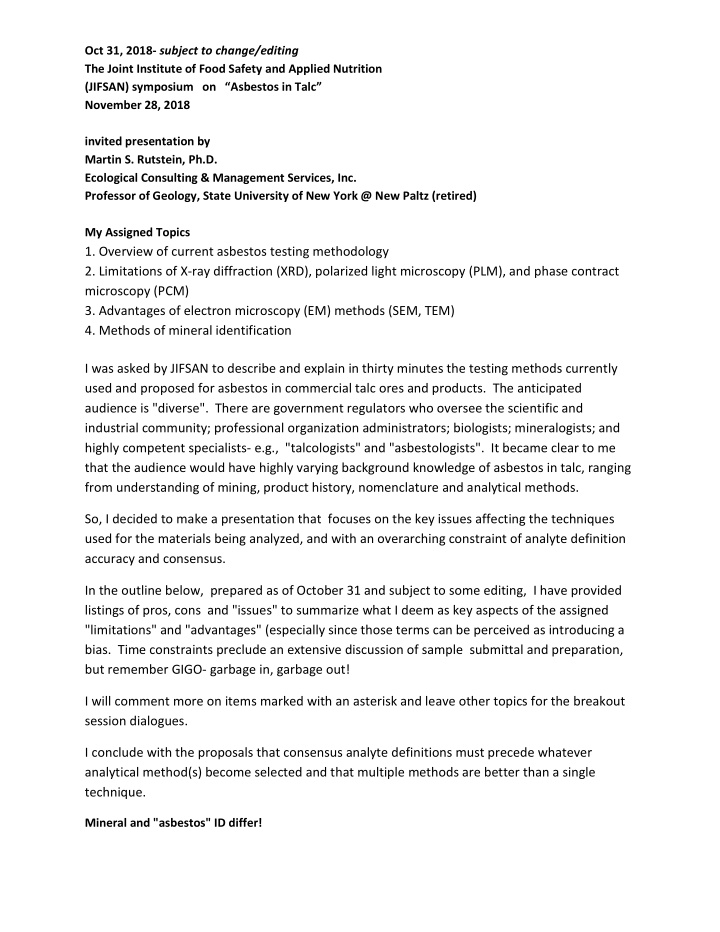



Oct 31, 2018- subject to change/editing The Joint Institute of Food Safety and Applied Nutrition (JIFSAN) symposium on “Asbestos in Talc” November 28, 2018 invited presentation by Martin S. Rutstein, Ph.D. Ecological Consulting & Management Services, Inc. Professor of Geology, State University of New York @ New Paltz (retired) My Assigned Topics 1. Overview of current asbestos testing methodology 2. Limitations of X-ray diffraction (XRD), polarized light microscopy (PLM), and phase contract microscopy (PCM) 3. Advantages of electron microscopy (EM) methods (SEM, TEM) 4. Methods of mineral identification I was asked by JIFSAN to describe and explain in thirty minutes the testing methods currently used and proposed for asbestos in commercial talc ores and products. The anticipated audience is "diverse". There are government regulators who oversee the scientific and industrial community; professional organization administrators; biologists; mineralogists; and highly competent specialists- e.g., "talcologists" and "asbestologists". It became clear to me that the audience would have highly varying background knowledge of asbestos in talc, ranging from understanding of mining, product history, nomenclature and analytical methods. So, I decided to make a presentation that focuses on the key issues affecting the techniques used for the materials being analyzed, and with an overarching constraint of analyte definition accuracy and consensus. In the outline below, prepared as of October 31 and subject to some editing, I have provided listings of pros, cons and "issues" to summarize what I deem as key aspects of the assigned "limitations" and "advantages" (especially since those terms can be perceived as introducing a bias. Time constraints preclude an extensive discussion of sample submittal and preparation, but remember GIGO- garbage in, garbage out! I will comment more on items marked with an asterisk and leave other topics for the breakout session dialogues. I conclude with the proposals that consensus analyte definitions must precede whatever analytical method(s) become selected and that multiple methods are better than a single technique. Mineral and "asbestos" ID differ!
Example -What is a single fiber? "Answer"- It’s “likely” to be asbestos on the basis of: Aspect ratio Width -Length Parallel sides Terminations Unit cell Chemistry “Population” Nomenclature Litigation ANALYTICAL METHODS Eyesight observations Advantages: Rapid sorting of some samples Disadvantages/ Limitations/Issues: Magnification limits only "sees" shapes Light Microscopy- PLM & PCM Phase Contrast Microscopy (PCM) not discussed; mainly for air samples. Polarized Light Microscopy (PLM) PLM Advantages: Codified by EPA * Widespread usage * Relatively inexpensive Rapid turn-around Standardized rules Dispersion staining Becke Line Good for building materials Good for “bulk materials” “Sees” range of fiber sizes Skill levels
PLM Disadvantages/ Limitations/Issues: Magnification limit ~400x * Smallest fibers can be masked by matrix Non-friable materials opaque Variations in mineral chemistry changes RI Becke Line techniques “harder” (pleochroism, extinction, RI, …) Quantification XRD for Asbestos, talc & “fibers” XRD Advantages: Rapid turn-around Standardized rules Reference standards Good for gross phase ID Identifies sample mineral assemblage Semi-quantitative for amounts improvable by concentration (sieving, elutriation) More quantitative with standards ( slow scan) “Sees” almost all size fractions XRD Disadvantages/ limitations/”issues”: Measure atomic spacings Phase ID errors Expensive Need reference standards Sample “mounts” powder “packing” grain orientation Analysts expertise & skills Radiation protocols Instrument calibration “Poor” shape information Overlap 2 theta peaks * Detection limits * fast, slow scans SEM for Asbestos, talc & “fibers” Advantages: Visual magnification of shape Chemistry by EDS
Disadvantages/ Limitations/Issues: Versus TEM, the “Gold” standard * Expensive Analyst expertise Instrument calibration No structural capability * Can’t discriminate some amphiboles * Interpretation of- “shapes”/morphologies asbestos present and amount(s) TEM for Asbestos, talc & “fibers” Advantages: Perceived as AHERA “Gold” standard * Relatively widespread usage * Shape via visual ID Calcium amphiboles TEM Disadvantages/ Limitations/Issues: Aspect ratio % Population and amounts * Detected vs. Not-detected * Confirmed vs. non-confirmed * “Sees” only smaller size particulates Phase ID errors (amphibole species) Expensive Need reference standards Analyst expertise Instrument calibration Interpretation “shapes”/morphologies Talc vs. anthophyllite - Twisted talc ribbons/fibers “kinky” talc * Talc-Tremolite-Anthophyllite Chemistry and structure issues Goal for Talcs: “prove” absence of relevant amphiboles and chrysotile
Need a full spectrum of analytical tools, applied in context of a common analyte definition, to assert problematical levels of concern! Conclusions: PLM will remain primary technique given its simplicity and widespread availability. SEM & PCM useful supplements. XRD especially useful to confirm presence of amphiboles. TEM and EDX likely to be “ultimate” analytical tool But ONLY IF we agree on definition of “phase” names and relevant shapes! & Remember that AHERA TEM method allows for “Ambiguous” & “Indeterminate” or We just don't know!
Recommend
More recommend